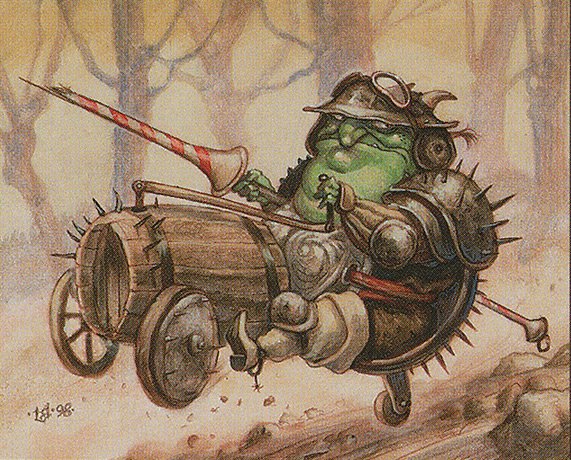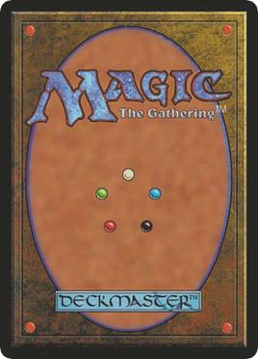 Art by DiTerlizzi
Art by DiTerlizziOne of the best ways to engage with Magic is through the booster draft format. This is traditionally done with booster packs, but those are expensive and often the power level of cards varies wildly. To combat that, I’ve cultivated my own unique list of really powerful and awesome cards from every era of Magic for us to draft with.
- Each player will sit around the table in a random spot
- Each player will receive 3 16 card packs randomly from the cube
- Each player will open a pack of cards and select one
- They will pass the remaining cards to the next player in order
- They will receive cards from the previous player in order
- Repeat steps 3-5 until each player has 16 cards in front of them
- Repeat steps 3-6 until every card from each pack has been drafted
The first and third packs are passed to the left, the second to the right
Additional rules:
Drafting is mentally taxing - You may look at the cards you have drafted at any point during the draft, but be careful not to mix your cards with the cards in the pack you are selecting from.
Zone Draft - If the next player in turn order already has a pack waiting for them, DO NOT PASS them another pack. You may select a card from your pack, but hold onto it until the next player has no pack waiting for them. This makes things move much more smoothly.
- Your deck must contain at least 40 cards, but has no maximum size
- Your deck may only contain the cards you drafted and basic lands
- In most decks, you will run 17 lands.
- You may make any edits to your deck in between games.
- 3 Rounds of Swiss
- Random pairing round one
- Success based pairing rounds two and three
- Best of 3 Matches
- 50-minute timer per match
- This is primarily to keep things moving, if more time is needed we can make that happen
Cube can be overwhelming, especially for people without much Magic experience. That’s part of what makes it fun. To start, pick the cards that seem the most interesting or powerful, and draft other cards that seem similar. If you stop seeing cards like it, someone else is probably going for the same ideas as you, and it’s time to switch it up. You only need 23 playable cards out of 48 picks, so don’t be afraid to not play your first picked card or to switch lanes late.
If you don’t know what to pick, lands are always a high priority.
Fetchlands are the bread and butter of this cube - giving you access to the perfect colors of mana and putting a card into your graveyard to be used for something else later.
Shocklands are almost as important - lands that tap for 2 colors, but can also be grabbed by fetchlands. Note: Any shockland can be grabbed by SEVEN of the ten fetchlands.
We’re drafting a Deck - not cards.
Well how do we do that? Let’s take a look at some of the different archetypes in the cube. In most cases, you’ll want to play 2 colors. Sometimes just one, sometimes a bunch. As new drafters - shoot for 2.
Here are some highlights in each color -
 White
White  - Aggressive Creatures, cheap recursion, efficient removal
- Aggressive Creatures, cheap recursion, efficient removal
 Blue
Blue  - Card draw, counters/control, artifact synergies
- Card draw, counters/control, artifact synergies
 Black
Black  - Sacrificing your own creatures, recursion, making opponent discard
- Sacrificing your own creatures, recursion, making opponent discard
 Red
Red  - Aggressive creatures, artifact synergies, instants/sorceries synergies
- Aggressive creatures, artifact synergies, instants/sorceries synergies
 Green
Green  - Land synergies, returning cards from graveyard to hand, graveyard hate
- Land synergies, returning cards from graveyard to hand, graveyard hate
 White / Blue - Flicker
White / Blue - Flicker 
In this archetype we utilize cheap creatures with strong enter the battlefield (ETB) effects to generate early tempo, then use effects to “flicker” our creatures - remove them from the battlefield and return them, resulting in another instance of their ETB.
 White / Blue - Tameshi Recursion
White / Blue - Tameshi Recursion 
This is a deck based primarily around a single card, Tameshi, Reality Architect, that generates value by recurring artifacts from the graveyard. It plays as a slower deck, utilizing cantrips such as consider and thought scour for card selection and graveyard filling. This deck wins through cards such as walking ballista or sai, master thopterist
 Blue / Black - “Garbage”
Blue / Black - “Garbage” 
Blue black tends to play in the midrange variety with efficient hand hate and card selection, utilizing cards such as Oskar, Rubbish Reclaimer to generate excessive amounts of value. Cards like Drown in the Loch and Lochmere Serpent get stronger as your opponent’s graveyard fills. Win the game by making a massive Psychatog by getting rid of everything that was sent back initially by Upheaval.
 Black / Red - “Aristocrats”
Black / Red - “Aristocrats” 
Named for Falkenrath Aristocrat, the aristocrats strategy is the sacrificing of your own creatures as a way to generate value. This could be in the form of buffing your own creatures, dealing damage to your opponent, or drawing cards. It’s important in this archetype to have a surplus of token creators, and strong ways to utilize them.
 Red / Green - Lands
Red / Green - Lands 
Play lands, play dumb things, sacrifice your lands, do dumb things. Red/Green lands is a deck for all you meatheads. Get strong effects from playing lands, such as rocks to throw at your opponent, sacrifice them to get more value, more mana, or elementals, and win by throwing the land itself at your opponent.
 Green / White - Midrange
Green / White - Midrange 
Play efficient threats and interaction and control your opponent’s access to their resources. Cards like Yasharn, Implacable Earth and Thalia, Guardian of Thraben are efficient creatures that do just that. Cards like Glimpse of Nature and Rite of Harmony make every creature you play replace itself, allowing you to continually outvalue your opponent.
 White / Black - Midrange Reanimator
White / Black - Midrange Reanimator 
Play efficient threats and interaction and control your opponent’s access to their resources. Reanimate your cheap creatures when they die to generate more value through their ETB effects. Remove even the peskiest things your opponent has.
 Blue / Red - Spells
Blue / Red - Spells 
Utilize cheap draw and burn spells to generate card advantage and maintain stability on board, then empty your graveyard for a Murktide Regent or Ethereal Forager. Slower variants of the deck have access to Rise from the Tides or Sentinel Tower.
 Blue / Red - Artifacts
Blue / Red - Artifacts 
Combine Goblin Welder strategies with Emry, Lurker of the Loch strategies to create a super fun artifact deck.
 Black / Green - Graveyard Midrange
Black / Green - Graveyard Midrange 
Remember how this cube does a lot with the graveyard? Fill it up with Stitcher’s Supplier and Satyr Wayfinder, beef up your Tarmogoyf, and get rid of the rest with Deathrite Shaman. Dredge cards, Life from the Loam and Dakmor Salvage offer fantastic card selection between black reanimation spells and green regrowth style spells.
 Red / White - Recursion/Artifacts
Red / White - Recursion/Artifacts 
If you end up in Red or White but don’t feel like playing aggro, not a problem! Cards like Venerable Warsinger and Osgir, the Reconstructor are great at bringing back all kinds of goodies for more value. This deck could also end up with Goblin Welder effects, with the ability to bring back Cataclysmic Gearhulk or even small removal Portable Hole.
 Blue / Green - Lands
Blue / Green - Lands 
For those slightly smarter than red green, ramp into some more distinguished threats. Cosima, God of the Voyage and Jadzi, Oracle of Arcavios are some interesting high end pieces, and blue also offers Trade Routes. Slogurk, the Overslime does a great impression of Life from the Loam, and Grolnok, the Omnivore is a cute frog.
- Chrome Host Seedshark
- Master of Death
- Mishra's Bauble
- Witch's Oven
- Lotus Petal
- Nettlecyst
- Portal to Phyrexia
- Reito Sentinel
- Riveteers Ascendancy
- Endless Detour
- Honored Heirloom
- Syr Ginger, the Meal Ender
- Fleetwheel Cruiser
- Hope of Ghirapur
- Kogla and YidaroEscape to the Wilds
- Alesha, Who Smiles at DeathJan Jansen, Chaos Crafter
- GroundskeeperCenote Scout
- Deathgorge ScavengerSentinel of the Nameless City
- Scion of DarknessTroll of Khazad-dûm
- Dockside ChefFaerie Dreamthief
- Deadeye TrackerCauldron Familiar
- Bloodsoaked ChampionStalactite Stalker
- Deal BrokerCogwork Librarian
- Lord Skitter, Sewer KingGrief Art Card
- Never // ReturnBone Miser
- DarkblastSinister Concoction
- Feed the SwarmMephitic Draught
- Doom Foretold
- Klothys, God of Destiny
- Gyruda, Doom of Depths
- Lurrus of the Dream-Den
- Tinker
- Jace, Wielder of Mysteries
- Faithless Looting
- Bone Shards
- Phyrexian Metamorph
- Tasigur, the Golden Fang
- Magda, Brazen Outlaw
- Scrapheap Scrounger
- Eternal Witness

